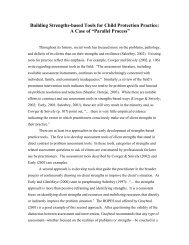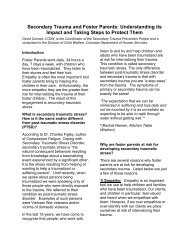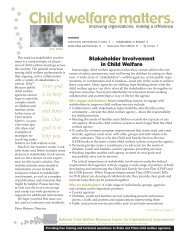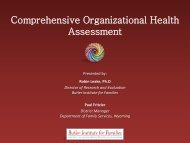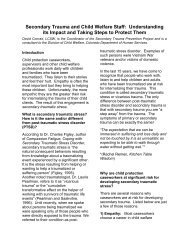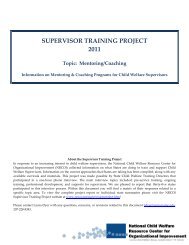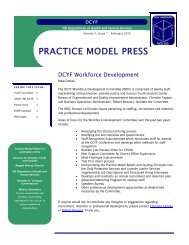Building a Model and Framework for Child Welfare Supervision
Building a Model and Framework for Child Welfare Supervision
Building a Model and Framework for Child Welfare Supervision
Create successful ePaper yourself
Turn your PDF publications into a flip-book with our unique Google optimized e-Paper software.
include "acknowledging effective per<strong>for</strong>mance, caseworker ef<strong>for</strong>ts, client progress,<br />
accomplishment, <strong>and</strong> individual contributions” <strong>and</strong> treating staff “with importance, dignity, <strong>and</strong><br />
respect.” Similarly, Salus (2004) encourages supervisors to provide both positive feedback <strong>and</strong><br />
recognition to frontline practitioners: “Positive feedback rein<strong>for</strong>ces those specific aspects of<br />
per<strong>for</strong>mance that the supervisor wants a caseworker to continue doing, whereas recognition is a<br />
general appraisal of someone’s ef<strong>for</strong>ts or accomplishments” (pp. 51-52). Kadushin <strong>and</strong> Harkness<br />
(2002) note that, “The supervisor supports by praising <strong>and</strong> commending good per<strong>for</strong>mance <strong>and</strong><br />
communicates agency appreciation <strong>for</strong> the workers’ ef<strong>for</strong>ts. . . One worker talked about ‘kudos<br />
memos,’ complimenting her on<br />
something she had done, that her<br />
supervisor occasionally dropped in her<br />
mailbox” (p. 256). Recognition of<br />
effective per<strong>for</strong>mance <strong>and</strong><br />
accomplishment is meaningful when<br />
given individually <strong>and</strong> private, but it is<br />
… underst<strong>and</strong>ing more about how we communicate has<br />
been helpful; mistakes are not discussed in a punitive way,<br />
but to learn. We try to rein<strong>for</strong>ce initiative taken by<br />
supervisors as well. – Administrator<br />
also important to praise publicly. For example, Hughes, et al. (1991:p. 6.6) suggest that<br />
organizations encourage supervisors to nominate a “worker of the week.”<br />
Involve Supervisors in the Organizational Communication Chain. Another key aspect of<br />
building an organizational, office, <strong>and</strong> team culture that values supervisors' pivotal role is<br />
recognizing their position as a key conduit between the organization’s administration <strong>and</strong> staff.<br />
Supervisors play a vital role in translating <strong>and</strong> connecting the mission, vision <strong>and</strong> values of the<br />
agency to practice <strong>and</strong> outcomes. Kadushin <strong>and</strong> Harkness<br />
emphasize that, “The supervisor is one of the principal<br />
Supervisors provide a feedback<br />
gatekeepers in the communications system, gathering,<br />
loop to upper management<br />
interpreting, distilling, <strong>and</strong> evaluating in<strong>for</strong>mation received because they are on the<br />
from others in the hierarchy <strong>and</strong> transmitting this in<strong>for</strong>mation<br />
frontline. – Administrator<br />
to others in the hierarchy” (2002:64).<br />
Supervisors <strong>and</strong> others in the organization must underst<strong>and</strong> <strong>and</strong> be com<strong>for</strong>table with their role in<br />
communication. Supervisors must be willing <strong>and</strong> able to carry out their role in the open, accurate,<br />
timely flow of communication both ways (CO DHS 1994: p. 5). However, the organization’s<br />
leadership <strong>and</strong> management must consistently validate <strong>and</strong> actively support supervisors in their<br />
responsibility to communicate up <strong>and</strong> down the hierarchy. They do so by providing in<strong>for</strong>mation in a<br />
timely <strong>and</strong> complete way.<br />
A very important support to me as a supervisor is the<br />
As a channel of organizational<br />
creation <strong>and</strong> maintaining of an atmosphere of asking<br />
communication, supervisors must have “why?”—where critical thinking <strong>and</strong> open communication<br />
credibility within the organization <strong>and</strong> are valued <strong>and</strong> expected. One caseworker asked “why?”<br />
community. This credibility is enhanced<br />
in a staff meeting <strong>and</strong> then told her supervisor she thought<br />
when supervisors have been involved in<br />
<strong>and</strong> provided full in<strong>for</strong>mation about policy<br />
she might be fired <strong>for</strong> it. But the administrator leading the<br />
<strong>and</strong> practice changes be<strong>for</strong>e they are meeting actually praised her <strong>for</strong> speaking up <strong>and</strong><br />
made; then supervisors can be fully questioning. – Supervisor<br />
prepared to clarify the rationale <strong>for</strong> <strong>and</strong><br />
nature of the changes to others. Supervisors help foster ownership by communicating in a timely<br />
way about the agency’s mission, philosophy of practice, goals, values, policies, <strong>and</strong> procedures, <strong>and</strong><br />
by providing opportunities <strong>for</strong> staff to ask questions <strong>and</strong> have input when changes are being<br />
considered (CO DHS 1994). Supervisors, however, cannot openly <strong>and</strong> accurately communicate<br />
28




